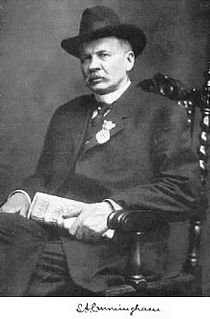
The United Daughters of the Confederacy (UDC) is an American hereditary association of Southern women established in 1894 in Nashville, Tennessee. The stated purposes of the organization includes the commemoration of Confederate States Army soldiers and the funding of the erection of memorials to these men. Many historians have described the organization's portrayal of the Confederate States of America (CSA), along with its promotion of the Lost Cause movement, as advocacy for white supremacy, and have asserted that promotion of the Confederate tradition has been led by the UDC. Until recent decades, the UDC was also involved in building monuments to commemorate the Ku Klux Klan.

The United Confederate Veterans was an American Civil War veterans' organization headquartered in New Orleans, Louisiana. It was organized on June 10, 1889, by ex-soldiers and sailors of the Confederate States as a merger between the Louisiana Division of the Veteran Confederate States Cavalry Association; N. B. Forrest Camp of Chattanooga, Tennessee; Tennessee Division of the Veteran Confederate States Cavalry Association; Tennessee Division of Confederate Soldiers; Benevolent Association of Confederate Veterans of Shreveport, Louisiana; Confederate Association of Iberville Parish, Louisiana; Eighteenth Louisiana; Adams County (Mississippi) Veterans' Association; Louisiana Division of the Army of Tennessee; and Louisiana Division of the Army of Northern Virginia.

The Sons of Confederate Veterans (SCV) is an American nonprofit and charitable organization of male descendants of Confederate veterans headquartered at the Elm Springs in Columbia, Tennessee. The SCV was founded on July 1, 1896, at the City Auditorium in Richmond, Virginia, by R. E. Lee Camp, No. 1, Confederate Veterans. It is known for erecting and maintaining American Civil War memorials and graves, observing Confederate Memorial Day, and encouraging Southern historical study. Activists have placed new emphasis on the controversial right to display Confederate symbols in public.

The Lost Cause of the Confederacy, or simply the Lost Cause, is an American pseudo-historical, negationist ideology that holds that the cause of the Confederacy during the American Civil War was a just and heroic one. The ideology endorses the supposed virtues of the antebellum South, viewing the war as a struggle primarily to save the Southern way of life, or to defend "states' rights" such as the right to secede from the Union, in the face of overwhelming "Northern aggression." At the same time, the Lost Cause minimizes or denies outright the central role of slavery in the buildup to and outbreak of the war.

Allen George Newman III was an American sculptor, best known for his statue The Hiker.
Eliphalet Frazer Andrews, an American painter known primarily as a portraitist, established an art instruction curriculum at the behest of William Wilson Corcoran at his Corcoran School of Art, and served as its director, 1877–1902. He received many commissions to copy images of famous Americans, those copies are displayed by federal, state and local institutions, including the Smithsonian American Art Museum.

The Confederate Memorial is a memorial in Arlington National Cemetery in Arlington County, Virginia, in the United States, that commemorates members of the armed forces of the Confederate States of America who died during the American Civil War. Authorized in March 1906, former Confederate soldier and sculptor Moses Jacob Ezekiel was commissioned by the United Daughters of the Confederacy in November 1910 to design the memorial. It was unveiled by President Woodrow Wilson on June 4, 1914.

Sumner Archibald Cunningham was an American Confederate veteran and editor. He was the founder and editor of The Confederate Veteran, a monthly magazine about veterans of the Confederate States Army.

Florida's Tribute to the Women of the Confederacy, also known as A Tribute to the Women of the Southern Confederacy and the Monument to the Women of the Confederacy, is an outdoor Confederate memorial installed in Jacksonville, Florida's Confederate Park, in the United States. It is a tribute to women of the South who sacrificed greatly during 1861 to 1865.

For decades in the U.S., there have been isolated incidents of removal of Confederate monuments and memorials. Several U.S. states have passed laws to hinder or prohibit further removals.

The Confederate Private Monument is a bronze sculpture of a private of the Confederate States Army in Centennial Park, Nashville, Tennessee, United States. Designed by George Julian Zolnay, it was commissioned by the Frank Cheatham Bivouac of the United Confederate Veterans in 1903, laid with Masonic honors in 1907, and dedicated in 1909. It was vandalized in June 2019.

The Confederate monument, also known as Old Joe, was a historic statue in Gainesville, Florida, in the United States. Designed by John Segesman, it was dedicated by the United Daughters of the Confederacy outside the Alachua County Administration Building in 1904. It was moved to a privately owned cemetery in rural Alachua County on August 14, 2017.
The McNeel Marble Works of Marietta, Georgia, was founded in 1892 by Morgan Louis McNeel and his brother, R. M. McNeel. Its location near the Blue Ridge Mountains provided the firm with access to areas where marble and granite could be quarried.

The United Confederate Veterans Memorial is a granite Confederate monument in Seattle's privately-owned Lake View Cemetery, in the U.S. state of Washington. The memorial was erected by the United Daughters of the Confederacy in 1926. It is constructed of granite from Stone Mountain.
Laura Martin Rose (1862–1917) was a propagandist for the Ku Klux Klan employed by the United Daughters of the Confederacy.

The Confederate Memorial, was installed in Jacksonville, Florida's Hemming Park, in the United States. The monument was removed in June 2020.


















